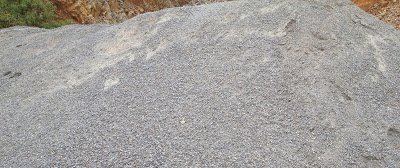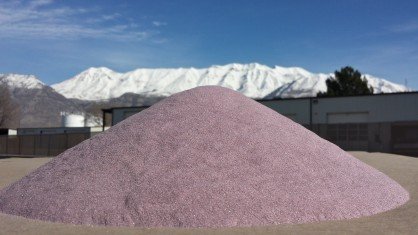Concrete Without Sand? A Sure Thing.
The world is silently conducting its affairs over a heap of a potential alternative for sand and yet feign ignorance of this fact. People seem to actually be constructing one thing or the other these days; if not a house, then it could be a shed. While the idea of having a building constructed in one's name seem to be a noble task enough, the materials to be used seem to be scanty each passing day.
Concrete, a composite material composed of aggregates (sand and gravel), water and cement, they say, is the third most consumed material after air and water, with as much as three tonnes consumed per person per annum (on the average). A reportby the guardian relates that Nigeria consumes as much as 30 million metric tonnes of concrete annually which of course translates to the fact that we are still very much behind Asia, Europe and America, where China is confirmed to have been consuming as much as 2400 million metric tonnes of concrete in 2017 as reported by Statista.See? I think Africa still have a long way to go but let's come to think of it, does the planet has enough sand to withstand the immoderate demand for the commodity particularly in concrete for construction?
The price of sand is becoming outrageous even locally! And one is bound to refute the idea of having anything built without sand. "How is that even possible?", you may ask. Well, you are not the only one at that crossroad (If that situation can ever be referred to as crossroad). I once had a discussion on this issue with a friend who had suggested the use of glass, crushed glass, as an alternative for sand. But then, one is still confronted with the need of sand anyway. I mean what is glass but a molten sand.
The construction industry is presently experiencing an heightened boom in value and operations. Thus, the demand for sand is almost as staggering as that of air and water for survival. And if it will be taken as an exaggeration, I would have claimed that the need for sand is beginning to surpass that of water. Well, don't take me up for that - I didn't claim it after all. My last article addressed the issue of the dangers of sand mining (an operation that ensure the availability of sand for use in construction), conclusively demanding a break in the operations and asking for governmental sanctions on them. I also charged the construction industries to seek for alternatives for sand elsewhere. This was a task whose solution I ordinarily thought stares at the face of everyone. However, for the benefit of those who demand to know what alternative there is for sand in construction industry, I have embarked on a little research on it and intend to present them as follows.
Alternatives for Sand
Quarry dust

Image Credit: Ghana Const.
Quarry dust is considered a waste material at the crusher unit during quarrying operations, constituting about 20 to 25% of the total production. My final year university project was to conduct a research to confirm the possibility of replacing sand with quarry dust in concrete. Well, my conclusion was in affirmation of the querry. However, according to one Mr. Sumit Raksit of Cushman and Wakefield located in India suggested thus
“Artificial sand or manufactured sand is fast emerging as the clear alternative for the conventional river sand, a rapidly depleting and excessively mined natural resource essential in supporting the natural hydrological cycle. This non-conventional fine aggregate is manufactured by crushing either granite or basalt rock using a three-stage crushing process under controlled conditions resulting in consistent quality independent of the seasonal fluctuations and inherent impurities.”
In effect, according to Mr. Raksit, quarry dust is a better alternative for construction purpose, better than sand itself. Infact, quarry dust is taken to possess more strength than sand and what more, it is a waste which is considerable cheaper than convetional sand.
Well, let's both wonder why the world isn't turning to this cheap and better material yet.
Foundry Sand

Image Credit: Cinder Company
Foundry sand is the aggregate of sand which forms a mould that is used during metal casting. Although this is an old method of casting employed in many foundry workshop, the method still thrive is some parts of the world. The various types of foundry sand include Green Sand, Water glass sand and Resin Sand. After multiple re-use, the sand needs to be discarded for replacement. This discarded material can be utilised for construction, thus reducing the need to mine for fresh sand for same purpose. A jornal published by Science Direct written by Mr. Siddique and Mr. Singh, titled Utilization of Waste Foundry Sand (WFS) in concrete manufacturing investigated the possibility of replacing sand in concrete. The jornal reported the possibility of achieving a considerable strength in concrete formed with foundry sand without compromising the splitting tensile strength, freezing-thawing resistance, shrinkage and modulus of elasticity of the concrete produced.
Copper slag
Image Credit: Quora
Currently, the world generates as much as 33 million of copper slag. It is a by product of copper extraction by smelting. The slag are the impurities that floats on the molten metal during smelting. It is also estimated that for every single ton of copper produced, about 2 tons of slag is produced along as waste. C.K. Madheswaran and some group of researchers once conducted on a research on the Use of Copper Slag as Replacement Material for River Sand in Building Constructions, the research shows that copper slag based mortal is suitable for plastering. Copper slag can be formed into blocks and used in concrete production as a partial or full replacement of sand. It can also serve as a landfill material. And even though they concluded that some adjustment/modifications should made to effect its high specific gravity and rough surface texture when used as a mortar, still it is found to be highly beneficial as it highly contributes strength.
Granulated blast furnace slag
Image Credit: Quora
GBFS (as it is mostly called) is gotten from by extinguishing molten iron slag from a blast furnace in water or steam producing a granular product which is later ground to produce a fine powder. It is beneficial as a direct replacement for Portland cement. A study conducted by some group of researchers from the National Institute of Technology Durgapur in India also conducted in study on the use of granulated blast furnace slag as a replacement for sand in concrete. According to the report of the study, it was concluded that the long term strength development of concrete made from the slag is double in all conditions (normal and marine). However, it was suggested that only about 40-60% of the slag to be used. Well, this can address the waste issue constituted by the slag over time, and the reduction in the use of sand where the slag is being utilised alongside.
Coal ash
Image Credit: Quora
It is a combustion residual of coal which is produced from the combustion of coal in coal-fired power plants. Its by-products include Fly Ash, Bottom Ash, Boller Slag, and Flue Gass Desulfurization material. A study conducted by Rafieizonooz and other researchers concluded that a concrete with 75% bottom ash and 20% fly ash has more flexural and splitting tensile strengths than normal concrete. It is further concluded that these concretes can be used in foundations, sub-bases and pavements thus minimizing the cost, energy and environmental problems associated with the disposal of coal ash.
Conclusion
Conclusively, a giant step into the industrial use of these materials in needed on the part of the construction industries. Sensitization and governmental backed enforcement is also needed to ensure appropriate compliance to stated standards associated with the use of these materials as replacement materials of sand in concrete.
If you'd enjoyed reading this and have learn one or two things, kindly upvote and resteem for the benefit of others.
Thank you.
References: Wikipedia, Guardian Ng, Statista, Down To Earth, Cinder Company, Quora
Your Post Has Been Featured on @Resteemable!
Feature any Steemit post using resteemit.com!
How It Works:
1. Take Any Steemit URL
2. Erase
https://3. Type
reGet Featured Instantly & Featured Posts are voted every 2.4hrs
Join the Curation Team Here | Vote Resteemable for Witness
We've got so much sand my end it'd be a while we'd run out of one. But it's good to see the alternatives.
Wow! Never knew we could actually replace sand in concrete. So many alternatives to sand.
Nice one
I don't think the other alternatives you mentioned have enough quantity to serve for long if everyone should switch away from using the normal sand. If possible someone has to take the leap before others will follow
Awesome post man. You should try to use images from free sources next time to be on the safe side. Appreciate your contribution to the steem blockchain
Thank you for the awareness. I will endeavor to heed to your suggestion.
No problem man. Check out the guideline of what images to use here
Being A SteemStem Member
Manufactured sand totally eliminates the presence of silt and organic impurities that otherwise hinder the setting time and compressive strength of structural concrete. So this is just perfect!